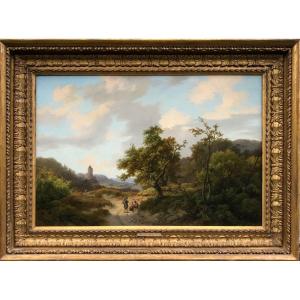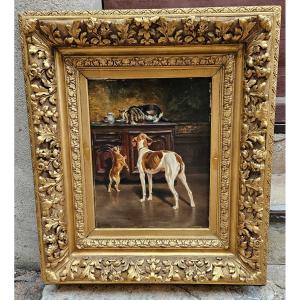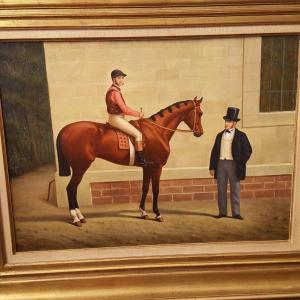Portrait of a Grey Horse
Material: Oil on canvas
Dimensions: 44 x 55 cm
Frame: Yes
Heinrich Lang was born on February 17, 1838 in Regensburg, Bavaria, Germany. Regensburg was an important cultural center in the 19th century, and Lang grew up in an environment rich in artistic and cultural influences. Lang had an early interest in animals and nature, which would later influence his artistic style, particularly in relation to horses. He likely received formal artistic training at the Munich Academy of Fine Arts, which was a major institution for German artists of the time. The Munich School of Painting, with its emphasis on naturalism and attention to detail, likely had an influence on Lang's development as an artist. It was also in Munich that Lang likely met many of the important artists of his time. Heinrich Lang is best known for his equestrian art. He had a remarkable ability to capture the grace, movement, and power of horses, and he was particularly adept at painting them in action, making him one of the most notable equestrian painters of his time. Lang's works often depicted horses in a variety of contexts, such as military or sporting settings, and he is particularly famous for his realistic depiction of the animal's anatomy and movement. His equestrian paintings were highly sought after, particularly by noble patrons and those who had a deep appreciation for horsemanship and cavalry.
Lang's style was highly detailed and naturalistic, which was characteristic of the academic tradition of his time. He paid great attention to the anatomy of horses and their realistic depiction in motion, whether galloping or at rest. This attention to realistic detail was a continuation of his training at the Munich Academy, which was renowned for the precision of its depictions. Lang's paintings were not only appreciated for their technical skill, but also for their emotional impact, as they captured the power and majesty of horses. He painted them in action scenes, such as cavalry charges, as well as in more intimate and serene moments, showing a deep connection between the horse and its rider or master. Throughout his career, Lang became known and respected for his work in equine portraiture and military scenes, and he exhibited his paintings in various galleries. His depictions of horses and cavalry were particularly appreciated by the aristocracy and military elite, who often commissioned works from him. His success as a painter of horses is also linked to the growing interest in horses and cavalry in 19th-century Europe, particularly following military conflicts such as the Napoleonic Wars and the Franco-Prussian War, in which cavalry played an important role.
Heinrich Lang died on April 17, 1891, in Munich, at the age of 53. While his name is not as well known today as some other 19th-century artists, his equestrian paintings remain highly regarded by collectors and connoisseurs of animal art. Heinrich Lang's contribution to the genre of equestrian painting has left a lasting legacy, particularly in his depiction of horses in motion. His works are occasionally included in exhibitions devoted to 19th-century German art, animal painting, and equestrian themes. Lang's equestrian paintings were often large in scale, showcasing his mastery of light, movement, and detail. His most famous works include depictions of military horses and scenes of horsemanship, in which he focused on the human-animal relationship. His paintings are held in private collections and museums, and occasionally appear at fine art auctions.


































 Le Magazine de PROANTIC
Le Magazine de PROANTIC TRÉSORS Magazine
TRÉSORS Magazine Rivista Artiquariato
Rivista Artiquariato